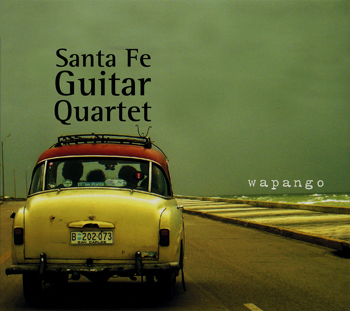Born on the island of Cuba in 1937, Paquito D'Rivera began his career as a child prodigy,playing both the clarinet and the saxophone with the Cuban National Symphony Orchestra. Since his defection from Cuba, Paquito D'Rivera has taken command of his role as a cross-cultural ambassador, creating and promoting a multinational style that moves from Bebop to Latin to Mozart. Throughout his career in the United States, Europe, Asia, and Latin America, D'Rivera's works have received rave reviews from the critics. D'Rivera has received many awards, including six Grammys, and his discography includes over 30 solo albums in jazz, bebop, Latin music, and classical music. In his quest to bring the Latin repertoire into the forefront of the classical arena, Paquito has successfully created, championed, and promoted all types of classical compositions. In addition to his extraordinary performing career as an instrumentalist, Paquito D'Rivera has rapidly gained a reputation as an accomplished composer. His works often reveals his versatility and widespread influences, which range from Afro-Cuban to the dance hall, to influences encountered in his many travels, and back to his classical origins.
In "Wapango," D'Rivera turns to the lively spirit and the rich rhythm of the Mexican couple dance called huapango, imaginatively balancing the fundamental relationship between the traditional and the new. His "Danzón" is based on the Cuban danzón, which evolved in the 1870s from the contradanza, becoming a distinctive creole blend of African rhythms with melodic elements drawn from the European country-dance. The rubato introduction of "Danzón" sets a romantic atmosphere followed by the danzón proper in clave, the rhythmic foundation of almost all Cuban music. Finally, the "Vals Venezolano" honors Antonio Lauro, Venezuela's most famous composer, in a lively, syncopated waltz.
Marcelo Coronel was born in Buenos Aires, Argentina, in 1962. He formalized his musical education the School of Music at the National University of Rosario. His main creative pursuit lies in the preservation and evolution of the folk music tradition. This can be understood as applying non-traditional musical language to the traditional rhythm, harmony, and melody of folk forms. Marcelo Coronel lives in Rosario (province of Santa Fe), where he divides his time between composing, performing, and teaching. "Germinacíon" is a chaya, a style of music from the province of La Rioja. The chaya is similar to the cueca from the neighboring region of Cuyo. The title expresses the happiness of a love that matures and engenders new life.
"Como un camino largo" is a zamba, a couple dance that came many years ago from Peru to what is now Argentina. The zamba is one of the most common song forms of Argentinean folk music, and its dance represents the intention of a man to gain the love of his partner. The mood of the zamba can vary in terms of the speed: there are fast, festive zambas and also the slow, nostalgic zambas. This piece is the latter.
"A la fuerza" is based on the gato, another couple dance, which is practiced in the central and northwest of Argentina. This gato shows a rhythmic characteristic that can be heard in various styles of the Latin-American folk music""the coexistence of 6/8 and 3/4 measures""which makes for a very interesting polyrhythm. The revision of this piece for a planned recording turned out to be somewhat complicated, and the composer finished it "a la fuerza" ("struggling")""hence the title.
Tango was the rage of Europe and America soon after World War I and was undistinguishable from the popular dance of the same name. This aggressive yet passionate tango, begotten in the brothels of turn-of-the-century Argentina and raised in the dance halls of Paris, became a quick, easy victim of parody. Tango became passé. In the mid-1950's, however, Argentinean composer Astor Piazzolla (1921-1992) began revolutionizing the tango. He created the Nuevo Tango by adding elements of dissonance, chromaticism, rhythmic complexity, and jazz. Piazzolla received death threats from Argentinean "nationalists" and tango purists in response to his radical treatment of the tango. Only recently has his music become accepted, both in Argentina and also in
concert halls throughout much of the world.
Piazzolla began writing Las cuatro estaciones porteñas [The Four Porteño Seasons or Four Buenos Aires Seasons] in 1965 and finished the suite in 1970. Originally written for his quintet of violin, bandoneón, electric guitar, piano, and contrabass, Las cuatro estaciones porteñas has become one of his best-known works. Piazzolla pays homage to the tango of Buenos Aires as well as the "serious" music of the great Italian composer Antonio Vivaldi. Vivaldian traces are most obvious in the closing bars of "Invierno porteño," and a fugue-like section begins "Primavera porteña." With a breath
of Nuevo Tango, Piazzolla gives new life to traditional classical forms.
In "Wapango," D'Rivera turns to the lively spirit and the rich rhythm of the Mexican couple dance called huapango, imaginatively balancing the fundamental relationship between the traditional and the new. His "Danzón" is based on the Cuban danzón, which evolved in the 1870s from the contradanza, becoming a distinctive creole blend of African rhythms with melodic elements drawn from the European country-dance. The rubato introduction of "Danzón" sets a romantic atmosphere followed by the danzón proper in clave, the rhythmic foundation of almost all Cuban music. Finally, the "Vals Venezolano" honors Antonio Lauro, Venezuela's most famous composer, in a lively, syncopated waltz.
Marcelo Coronel was born in Buenos Aires, Argentina, in 1962. He formalized his musical education the School of Music at the National University of Rosario. His main creative pursuit lies in the preservation and evolution of the folk music tradition. This can be understood as applying non-traditional musical language to the traditional rhythm, harmony, and melody of folk forms. Marcelo Coronel lives in Rosario (province of Santa Fe), where he divides his time between composing, performing, and teaching. "Germinacíon" is a chaya, a style of music from the province of La Rioja. The chaya is similar to the cueca from the neighboring region of Cuyo. The title expresses the happiness of a love that matures and engenders new life.
"Como un camino largo" is a zamba, a couple dance that came many years ago from Peru to what is now Argentina. The zamba is one of the most common song forms of Argentinean folk music, and its dance represents the intention of a man to gain the love of his partner. The mood of the zamba can vary in terms of the speed: there are fast, festive zambas and also the slow, nostalgic zambas. This piece is the latter.
"A la fuerza" is based on the gato, another couple dance, which is practiced in the central and northwest of Argentina. This gato shows a rhythmic characteristic that can be heard in various styles of the Latin-American folk music""the coexistence of 6/8 and 3/4 measures""which makes for a very interesting polyrhythm. The revision of this piece for a planned recording turned out to be somewhat complicated, and the composer finished it "a la fuerza" ("struggling")""hence the title.
Tango was the rage of Europe and America soon after World War I and was undistinguishable from the popular dance of the same name. This aggressive yet passionate tango, begotten in the brothels of turn-of-the-century Argentina and raised in the dance halls of Paris, became a quick, easy victim of parody. Tango became passé. In the mid-1950's, however, Argentinean composer Astor Piazzolla (1921-1992) began revolutionizing the tango. He created the Nuevo Tango by adding elements of dissonance, chromaticism, rhythmic complexity, and jazz. Piazzolla received death threats from Argentinean "nationalists" and tango purists in response to his radical treatment of the tango. Only recently has his music become accepted, both in Argentina and also in
concert halls throughout much of the world.
Piazzolla began writing Las cuatro estaciones porteñas [The Four Porteño Seasons or Four Buenos Aires Seasons] in 1965 and finished the suite in 1970. Originally written for his quintet of violin, bandoneón, electric guitar, piano, and contrabass, Las cuatro estaciones porteñas has become one of his best-known works. Piazzolla pays homage to the tango of Buenos Aires as well as the "serious" music of the great Italian composer Antonio Vivaldi. Vivaldian traces are most obvious in the closing bars of "Invierno porteño," and a fugue-like section begins "Primavera porteña." With a breath
of Nuevo Tango, Piazzolla gives new life to traditional classical forms.




